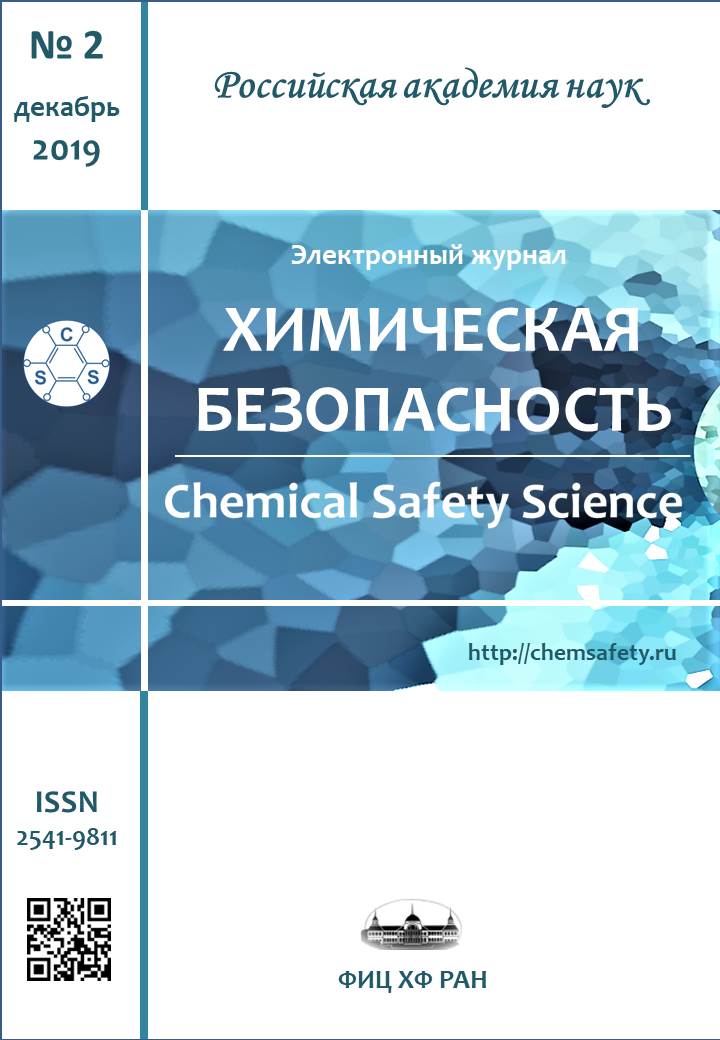Dynamics of Distribution of Heavy Metals and Arsenic in Dust Spray and Soils of Northern Tajikistan
Abstract
The article presents the results of determining content of heavy metals (or metal oxides) and arsenic in samples of atmospheric aerosol and soils of northern Tajikistan collected during 2013–2019. The results of a comparative analysis of the elemental composition of aerosol and soils highlighted their interannual variability, indicating a specific regional character of temporal variations which are mainly determined by dynamics of changes in the content of the examined substances affected by air mass changing. X-ray fluorescence technique has been used for analysis of the elemental composition of the samples and revealed the following highest concentrations of the examined substances in aerosol: strontium (376.8 ppm), zinc (2159.5 ppm), copper (118.8 ppm), manganese oxide (796.7 ppm), and vanadium (124.3 ppm) as measured in 2013; the highest content of arsenic (23.7 ppm) – measured in 2014; nickel (66.7 ppm), chromium (112 ppm), and titanium oxide (0.67%) – in 2015; lead (124.7 ppm) and cobalt (19.9 ppm) – in 2017. The measured concentrations in soil samples for the substances belonging to the first (arsenic, lead, zinc) and second hazard class (copper, nickel, cobalt, chromium) are found to exceed the levels of the corresponding maximum permissible values for many sampling locations. Possible sources of heavy metal and arsenic pollution are discussed, which are mostly of anthropogenic origin (automobile transport, metallurgical industrial enterprises, open tailing dumps, etc.).
References
Duffus J.H. “Heavy metals” a meaningless term? (IUPAC Technical Report) // Pure and Applied Chemistry. 2002. V. 74. P. 793. DOI: http://dx.doi.org/10.1351/pac200274050793.
The European Atmospheric Emissions Inventory of Heavy Metals and Persistent Organic Pollutants for 1990. UBA-TNO Report. Bonn, 1991. P. 158.
Bondarev L.G. Microelements – benefits and harms. M.: Znanie, 1984. P.144 [in Russian].
Health Aspects of Air Pollution – answers to follow- up questions from CAFE // Report on a WHO working group meeting Bonn, Germany, 15-16 January, 2004.
Khotimchenko S.A., Gmoshinsky I.V., Tutelyan V.A. // Gigiena i sanitariya [Hygiene and Sanitation]. 2009. No. 5. P. 7 [in Russian].
Senotrusova S.V., Khristoforova N.K. Atmospheric pollution and state of health of population of industrial cities. SPb.: Asterion, 2004. 246 p. [in Russian].
Nazarov B.I., Abdullaev S.F., Maslov V.A. Atmospheric aerosol of Central Asia. Dushanbe: Donish, 2017. 416 p. [in Russian].
Murtazaev Kh. Radiation-ecological features of natural environments of Northern Tajikistan. Khujand: Meroch, 2014. 164 p. [in Russian].
Zheng L., Zhou Z., Rao M. et al. // Environ. Geochem. Health. 2019. DOI: https://doi.org/10.1007/s10653-019-00428-x.
Rakhmatov M.N., Abdullaev S.F., Maslov V.A., Rasulzoda Kh.Kh. // Uchyonye zapiski KhGU [Bulletin of KhSU]. 2018. No. 3 (46). P. 56 [in Russian].
Rapuga V.F., Smolyakov B.S., Kutsenogyi K.P., Smirnova A.I., Yaroslavtseva T.V. // Sibirskii ekologicheskii zhurnal [Siberian ecological journal]. 2000. No. 1. P. 97 [in Russian].
Vinogradov A.A., Kotova E.I., Topchaya V.Yu. // Geografiya i prirodnye recursy [Geography and natural resources]. 2017. No. 1. P. 108. DOI: 10.21782/GIPR0206-1619-2017-1(108-116) [in Russian].
Snezhko S.I., Shevchenko O.G. // Uchyonye zapiski Ross. gosud. gidromet. univ. [Bulletin of Russian State Hydrometeorological University]. 2011. No. 18. P. 57 [in Russian].
Ji Y., Feng Y., Wu J., Zhu T., Bai Z., Duan C. // Journal of Environmental Sciences. 2008. V. 20. No. 5. P. 571. DOI: 10.1016/S1001-0742(08)62096-3.
Wood J.M. // Science. 1974. V. 183 P. 1049. DOI: 10.1126/science.183.4129.1049.
Rahman Z., Singh V.P. // Environ. Monit. Assess. 2019. V. 191 (7). P. 419. DOI: 10.1007/s10661-019-7528-7.
Vodyanitskii Yu.N. // Eurasian Soil Science. 2012. V. 45. No. 3. P. 321. DOI: 10.1134/S1064229312030131.
Abdullaev S.F., Maslov V.A., Rasulzoda Kh.Kh., Rakhmatov M.N. // Vestnik Tajikskogo natsyonalnogo universiteta [Bulletin of Tajik National University]. 2018. No. 1. P. 77 [in Russian].
RD [Regulatory Document] 52.04.186-89. Guide for controlling atmosphere. Introduction 1991-07-01. L.: Gidrometeoizdat, 1989. 615 p. [in Russian].
GOST [State Standard] 17.4.2.01-81 Nature protection. Soils. Nomenclature of sanitary conditions indices (as amended by N 1). M.: Standartinform, 2008 [in Russian].
GOST [State Standard] 17.4.4.02-84 Nature protection. Soils. Methods for sampling and preparation of soils for chemical, bacteriological, helminthological analysis. M.: Standartinform, 2008 [in Russian].
Abdullaev S.F., Nazarov B.I., Maslov V.A. et al. // Atmospheric and Oceanic Optics. 2013. V. 26. No. 5. P. 396. DOI: 10.1134/S1024856013050023.
Abdullaev S.F., Maslov V.A., Nazarov B.I. et al. // Optika i atmosfera okeana [Atmospheric and Oceanic Optics]. 2014. V. 27 No. 3. P. 207 [in Russian].
Abdullaev S.F., Maslov V.A., Nazarov B.I. et al. // Optika i atmosfera okeana [Atmospheric and Oceanic Optics]. 2015. V. 28. No. 2. P. 143 [in Russian].
Abdullaev S.F., Maslov V.A., Nazarov B.I. et al. // Optics of the atmosphere and the ocean. 2015. V. 28. No. 4. P. 347. DOI: 10.1134/S1024856015040028.
Hygienic standards GN 2.1.7.2041-06. Maximum permissible concentrations (MPC) for chemicals in soil. M.: Federal Hygiene and Epidemiology Centre, 2006 [in Russian].
Hygienic standards GN 2.1.7.2511-09. Approximate permissible concentrations of chemicals in soil. M.: Federal Hygiene and Epidemiology Centre, 2009 [in Russian].
Vinogradov A.P. Geochemistry of rare and trace elements. M.: Izd. AN SSSR, 1957. 238 p. [in Russian].
Copyright (c) 2019 M. N. Rakhmatov, V. A. Maslov, and S. F. Abdullaev

This work is licensed under a Creative Commons Attribution-NonCommercial 4.0 International License.












